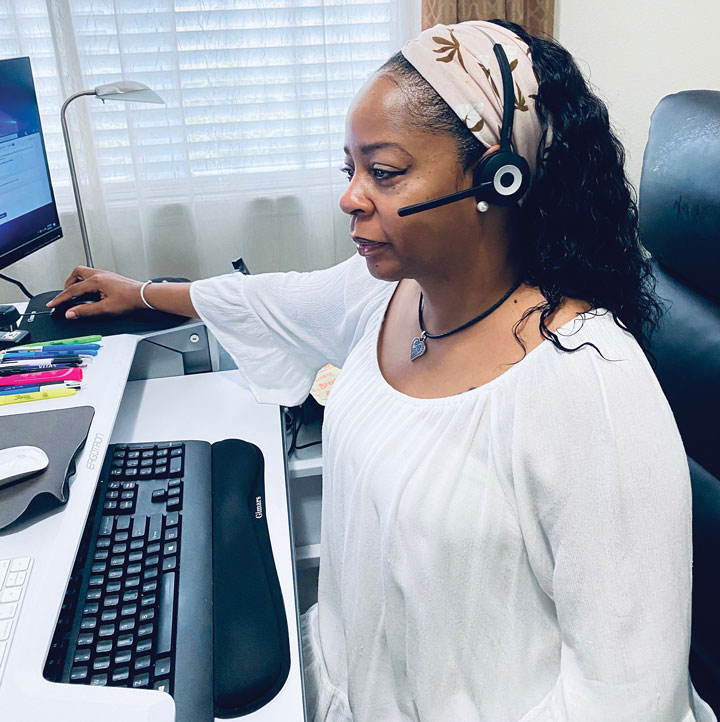Healthy Nurse, Healthy Nation™ Blog - Standing Desks: How Much Of An Impact Do They Have On Sedentary Nursing Jobs?
Published
 (Pictured: Roni Adams)
(Pictured: Roni Adams)Are you among the 1 in 4 American adults who spend more than 8 hours a day sitting? If you have a sedentary or work-from-home job, the answer is probably “yes.”
At Humana, many roles work from home, including their large population of nurses. When Joanie Howard, M.Ed., BSN, RN, CMCN, Director of Clinical Strategy & Practice at Humana posted an article on “sitting disease” to the company’s internal social media site, she did not expect what happened next.
“I put it out there to get a conversation going, and the response was overwhelming,” said Joanie. “Several nurses shared how although they loved the work they do at Humana, moving to a sedentary job had impacted their health negatively. Many nurses shared that they had gained weight, their blood pressure had gone up, and some started noticing various aches and pains from sitting most of the day.”
Joanie shared the feedback with Humana’s SVP and Chief Nursing Officer, Kathy Driscoll and SVP of Associate Well-being Tim State and through their support the idea of a standing desk pilot was born.
Identifying a Problem and Finding a Solution
What kind of impact does sitting for an extended period of time have on health? And is it worth to invest in ergonomic-friendly equipment, such as standing desks, for a sedentary job?
Those were the two questions the 3-month pilot study from Humana sought to answer. In late 2020, Humana launched a study among its own telephonic nurses who work from home. Approximately 100 randomly selected nurses (the intervention group) were given standing desks, and a control group of around 170 nurses did not have the equipment. Nurses with the standing desks could choose when to adjust the desk to stand and when to sit.
Both intervention and control groups were surveyed once a month for a period of 3 months. Survey questions covered a variety of health and wellness areas, including:
- Overall well-being
- Sense of belonging
- Mental health
- Unhealthy days vs. healthy days (using the Centers for Disease Control and Prevention’s validated Healthy Days metric)
- Stress levels
The results were impressive.
“At the end of the 3 months, we saw improvement in every area assessed for those in the intervention group,” said Joanie. “The control group mostly stayed the same, and in some areas got a little worse.”
Specifically, the intervention group reported:
- 3 hours less (on average) per day spent sitting
- Relief from lower and upper back, neck, and shoulder pain
- Increased focus
- More energy
The intervention group also reported, on average, 2 more days per month they described as feeling physically and mentally healthy.
Taking the Learnings Into the Future
Today, everyone who participated in the pilot study was offered a standing desk, including those in the control group. And because of the outstanding results, Humana plans for a multi-year roll-out supplying more employees with standing desks.
“We definitely hope to roll out more standing desks to our nursing population over time,” said Joanie. “Humana is committed to their associate’s health and well-being — that’s why we make investments in initiatives like the standing desk pilot to address employee needs — that’s what’s important.”
Now, what if you have a sedentary job but don’t have access to a standing desk? Joanie recommends the following options:
- Several Humana nurses who have access to Go365 have earned bucks quickly and purchased Amazon® gift cards to buy their own standing desk or riser.
- Schedule designated time in your calendar throughout the day to step away from your desk and increase your physical mobility.
- Take advantage of opportunities where you can do walking meetings in the workplace instead of sitting at a desk.
Science shows that sitting all day is not ideal. Getting out of your seat and standing — while remaining productive in your role — is a healthy compromise. Standing desks are beneficial for a sedentary job, and the Humana pilot study is proof.
Learn more about the health impacts of sitting and how standing desks can help.
Reviewed 12/8/22

Not a member of Healthy Nurse, Healthy Nation (HNHN) yet? Join us today!
Blog Physical Activity
11/02/2021 3:29pm CDT



Post a Comment or Question